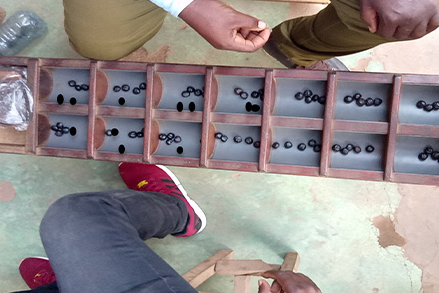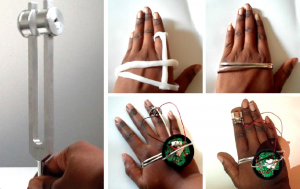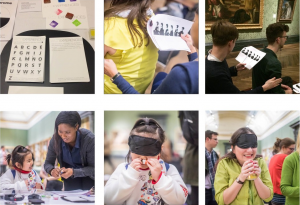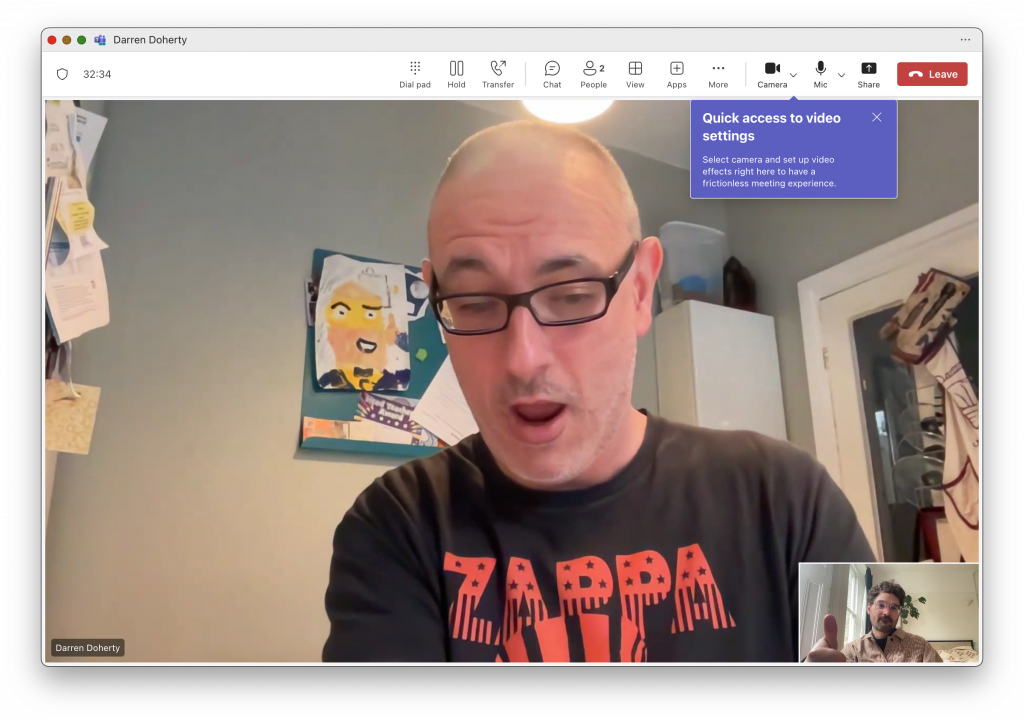Teaching Context & Positionality Statement
I primarily teach in the MA Design for Data Visualisation course at London College of Communication. The course has five main units. I run one of the units that stretches across the first three terms. Workshop sessions for the unit meet once a week, run for a full day, and explore relevant tools, technologies, methodologies, and storytelling techniques for working with a variety of datasets that are at times provided to students and other times collected by them. These datasets become the content for design outcomes that are iteratively developed and workshopped within the context of the tools and methodologies being explored.
My art and design teaching and practice emphasises multi-sensory experiences and embodied methods, deeply inspired by my neurodivergent perspective as an individual with ADHD. With this approach, I hope to enhance learning inclusivity, benefiting neurodivergent individuals as well as students who, in this case, speak Chinese as their primary language – and are learning in English for the first time. As a white, male, native English speaker educated in Western academic institutions, I am aware that the depth of my understanding around cultural differences is limited, especially since most of my students are from China (all but one) and are female (currently 89%). With ethnic representation that falls well outside of the institutional norm, according to UAL data, I have a unique intersectional opportunity in my teaching to stretch and inform my academic and artistic paradigms.

Intervention
The intervention I have designed is built around data walks (Hunter) and sound mapping activities using ‘The Speculative Listener’s Field Guide’ (Thompson, 2024) that I created for prompting Deep Listening (Oliveros, 2022) and subjective, multi-sensory contextual understanding about the data around the LCC campus in Elephant & Castle.
This intervention will take place during the MA Design for Data Visualisation unit 2 workshops early next spring term, 2025. As participants embed themselves in the dataset (urban environment), they walk; listen; record prompted reflections on the experience via field recordings, sketches, and journals; organise and analyse their data in small groups via desk-based research that engages with responsible design principles related to the discipline; and create outcomes that communicate their data stories with visual language and media developed through iterative, critical design practices.
Inclusivity: How and why?
“…to account for a plurality of cognitive and emotional experiences in a learning environment [we must consider] designing or facilitating space for neurodivergence, not in spite of it.”
(Crowley, 2021)
Intersection of Positionality, Space, and Identity
Positionality in research and teaching involves recognising how one’s social and cultural identities interact with space and context. This interplay affects both the research process and teaching practice, as discussed by Bayeck (2022), who highlights the dynamic nature of being an insider and outsider depending on the context and identity interactions. Donna Haraway’s “Situated Knowledges: The Science Question in Feminism and the Privilege of Partial Perspective” (1988) further emphasises that knowledge is always partial and situated, shaped by the specific perspectives of those who produce it. Haraway argues that acknowledging these partial perspectives allows for more responsible and accountable knowledge production, which is crucial in my teaching practice as it encourages an awareness of my own positionality and its impact on my students. In my case, being neurodivergent and having ADHD informs my multi-sensory and embodied teaching methods, creating an inclusive environment that caters to diverse learning needs.
Inclusivity for Neurodivergent Individuals and EAL Students
Bayeck (2022) emphasises the importance of cultural context in shaping research interactions. Similarly, my teaching approach considers the cultural and linguistic backgrounds of students, especially those who are English as an Additional Language (EAL) learners. This is crucial for Chinese students who might face additional challenges in an English-dominated academic setting. My methods, therefore, aim to bridge this gap by employing strategies that accommodate – and leverage – different sensory and cognitive preferences, making learning more accessible by including non-language-processing learning to benefit the EAL students and people with ADHD and related neurodivergent learning differences.
Navigating Cultural Differences
As a researcher and educator with a predominantly Western academic background, I acknowledge the limitations in my cultural understanding of my students. This self-awareness is essential for creating a respectful and responsive learning environment. Bayeck (2022) notes that conducting cross-cultural research requires sensitivity to local practices and values, which is equally applicable to teaching in a multicultural classroom. By incorporating feedback from students and continuously adapting my methods, I strive to mitigate these cultural gaps and enhance the inclusivity of my teaching practice.
Embodied Research Methods
Embodied research methods, which involve engaging with material and sensory experiences, are particularly effective for neurodivergent learners. This aligns with the idea that learning and literacy can occur through diverse, often non-traditional, modalities as explored in Bayeck’s study of African board games as spaces for literacy and learning.

By integrating such methods into my teaching, I support students in finding their unique ways of understanding and interacting with the subject matter.
Integration of Art, Design, and Neurodiversity
Luca M. Damiani’s research on neurodiversity in art and design further supports the effectiveness of multi-sensory and embodied methods. Damiani (2018) highlights how neurodivergent artists, including those with ADHD, autism, and dyslexia, use their unique perspectives to create inclusive and innovative art practices. In his project “My Aspie Hacks the Brain / Remix (2017),” Damiani uses illustrated patterns, photography, 3D, video, and coding to depict his autistic experience, emphasising the importance of diverse sensory inputs in understanding and creating art.

Similarly, Natasha Trotman’s work like “Alt Experiences” and “Tune In Tune Out”, which uses dyspraxic jewellery to create an embodied experience, fostering empathy and awareness about dyspraxia.


This approach aligns with my teaching methods, which aim to provide students with varied sensory experiences to enhance understanding and engagement. By incorporating such multi-sensory and embodied strategies, my teaching practice not only supports neurodivergent students but also promotes a deeper, more inclusive learning environment for all students.
Toolkits & Frameworks
The Inclusive Higher Education Framework (2023) emphasises the importance of providing equal opportunities for all students to succeed, regardless of their background or demographic characteristics. This framework moves away from making reasonable adjustments for individual students and instead considers the needs of a diverse student body as a whole. This approach aligns with my teaching philosophy, which aims to create an inclusive learning environment that addresses the varied needs of my students. I have the key principles outlined in their checklist (embedded below) a helpful guide as I continue to shape aspects of the delivery.
The framework also highlights that inclusivity does not mean compromising on academic standards. Inclusive programs can and should be academically rigorous while ensuring that all students have equal opportunities to succeed. This aligns well with my approach of integrating multi-sensory, object-based, (Chatterjee and Hannan, 2017) embodied methods into my teaching, ensuring that my students receive a high-quality education that respects their diverse learning needs.
Critical Pedagogy and Social Justice
Critical pedagogy and social justice are foundational to creating an inclusive educational environment. Freire’s concept of education as the practice of freedom emphasises the importance of dialogical and participatory teaching methods that empower students to become active participants in their own learning. This approach is particularly relevant in my teaching practice, where I aim to create a learning environment that respects and values the diverse experiences and perspectives of all students.
I found great inspiration – and solidarity – in the essay ‘The Emergence of an Extra-Terrestrial‘ by Annabel Crowley (2021). It explores themes of identity, otherness, and the experience of living with a disability. As captured in the quote from earlier in this blog, the piece emphasises the importance of creating spaces where neurodivergent individuals can express themselves and be understood. This resonates with my teaching philosophy, which aims to create an inclusive environment where all students feel valued and supported. By incorporating multi-sensory and embodied methods, I provide students with diverse ways of engaging with the material, fostering a sense of belonging and empowerment.
Conclusion
As I began to expand my understanding of intersectionality and inclusivity through my participation the PgCert course and this unit, I began to recognise the potential of certain non-verbal learning experiences and methodologies utilised in my teaching practice as inclusive practices – particularly around the intersectionality of neurodivergent, EAL, and non-western perspectives.

After uplifting conversations that included both positive and practical feedback from a colleague and my unit tutor, I have further considered resources like the ADHD UK welfare pack and some of their suggestions, and I plan to include additional structural elements into sessions like planned conversations and reflections from participants about the perceived inclusivity of their experience. I hope this kind of dialogue will help me continue to learn and adapt to expanding the accessibility and inclusivity of such activities by improving my knowledge of other people’s unique needs and perspectives (Haraway, 1988).
In summary, my positionality as a neurodivergent individual with ADHD, combined with my awareness of cultural differences, informs my inclusive teaching and research practices. By emphasising multi-sensory experiences and embodied methods, I aim to create an accessible and supportive learning environment for all students, particularly those who are neurodivergent or learning in a second language. This approach not only enhances inclusivity but also enriches the educational experience by valuing and integrating diverse perspectives and learning styles. The integration of insights from projects like those by Luca M. Damiani and Natasha Trotman, as well as the Inclusive Education Framework and the situated knowledge perspectives of Donna Haraway and Rebecca Bayeck (among others), further underscores the effectiveness and importance of these inclusive methods in art and design education.
References
ADHD UK (no date) Reasonable Adjustments Adjustments in the workplace for individuals with ADHD. Available at: https://adhduk.co.uk/reasonable-adjustments (Accessed: 10 July 2024).
Bayeck, R. Y. (2022). ‘Positionality: The Interplay of Space, Context and Identity’. International Journal of Qualitative Methods, Volume 21: 1–9. Available at: https://doi.org/10.1177/16094069221114745
Chatterjee, H.J. and Hannan, L. (2017) Engaging the senses: object-based learning in higher education. London: Routledge.
Hunter, D. (no date) Data Walking. Available at: https://datawalking.com (accessed 10 June 2024).
Crowley, A. (2021) ‘The Emergence of an Extra-Terrestrial’, Disability Arts Online, 11 October. Available at: https://disabilityarts.online/magazine/opinion/the-emergence-of-an-extra-terrestrial (Accessed: 12 July 2024).
Damiani, L.M. (2018) ‘On the spectrum within art and design academic practice’ Spark: UAL Creative Teaching and Learning Journal, Vol 3 / Issue 1 (2018) pp. 16-25. Available at: sparkjournal.arts.ac.uk/index.php/spark/article/download/88/146?inline=1 (Accessed: 25 June 2024).
Freire, P. (2000), Pedagogy of Freedom: Ethics, Democracy, and Civic Courage. New edition. Rowman & Littlefield Publishers.
Gawthorpe, P. & Hubbard, K. (2023) ‘Inclusive Higher Education Framework’, Inclusivity Toolkit. Available at: https://www.inclusiveeducationframework.info/wp-content/uploads/2023/05/Inclusive-Education-Framework-2.pdf (Accessed: 12 July 2024).
Haraway, D. (1988) ‘Situated Knowledges: The Science Question in Feminism and the Privilege of Partial Perspective’, Feminist Studies, Vol. 14, No. 3 (Autumn, 1988), pp. 575-599. Available at https://doi.org/10.2307/3178066
Oliveros, P. (2022) Quantum Listening. London: Ignota Books.
Thompson, J. (2024) ‘The Speculative Listener’s Field Guide’. MA Data Visualisation: Unit 02 Visualisation, tools, datasets and data stories. University of the Arts London. Unpublished.
Trotman, N. (no date) NATASHA TROTMAN FRSA MCSD FIEDP. Available at: https://natashamtrotman.com (Accessed: 12 July 2024).
University of the Arts London (2023) Equality, Diversity and Inclusion Annual report 2022/23. Available at: https://www.arts.ac.uk/__data/assets/pdf_file/0015/432141/SPCB23435-EDI-report-2022-23.pdf (14 July 2024).
Utah State University, Emma Eccles Jones College of Education and Human Services (2018) Classic African Board Game Songo a Space for Learning and Collaboration. Available at: https://cehs.usu.edu/news/2023/classic-african-board-game-songo-a-space-for-learning-and-collaboration (Accessed: 14 July 2024).
2 responses to “Intervention Reflective Report”
This is an exciting intervention/reflective report – almost has that psycho-geography feel that Will Sinclair and Will Self explore – I love the multi-sensory aspect of the intervention – the data walking research project is great – I think Staff would love to do this – I love the brief and the process – field recordings, sketches and journals and working together in small groups to reach their final outcomes – and the way it enables students, particularly international students to bridge the language gap as the collection of data doesn’t need to rely on the written word.
Incorporating feedback is also crucial and I think this is what I’m going to do for the Intervention that I’m working on too – I love that we don’t know if it will work or not, so feedback is crucial. Great work!
Thanks Darren!!